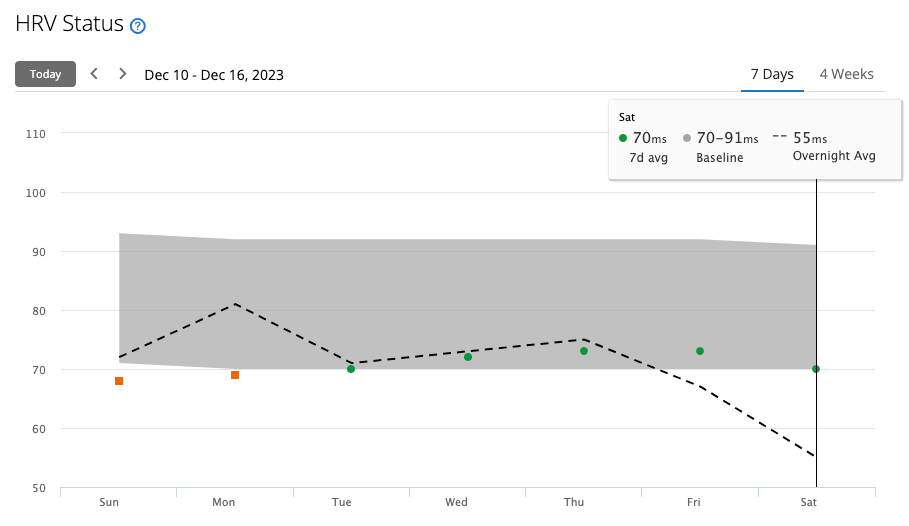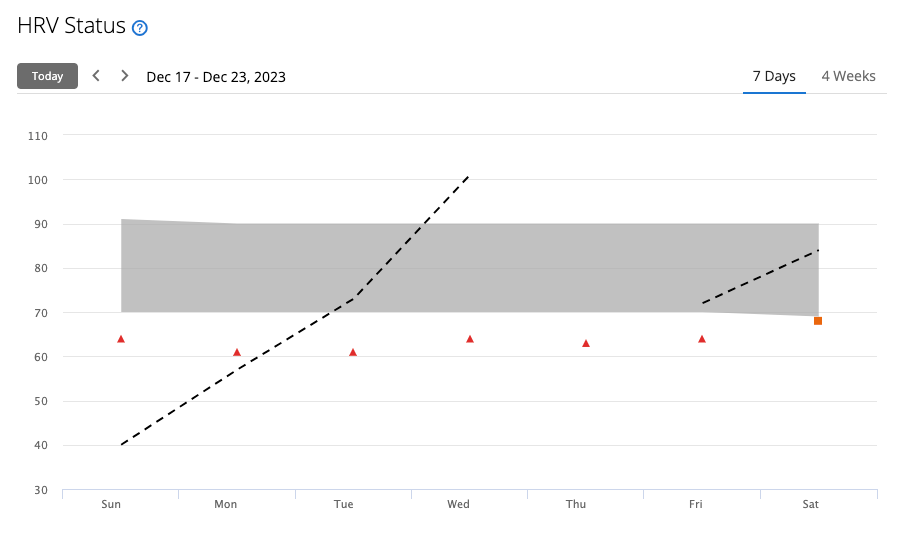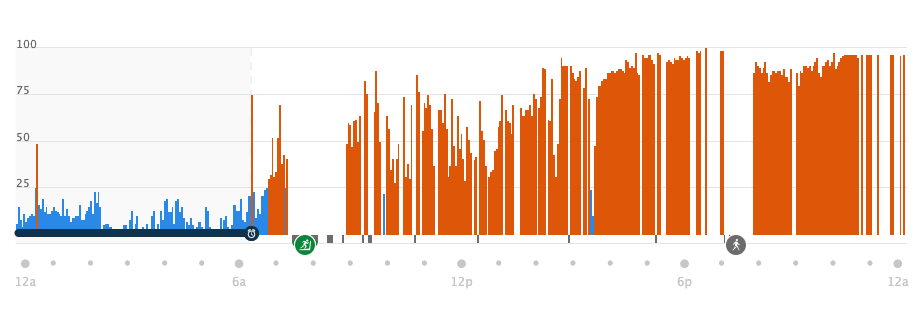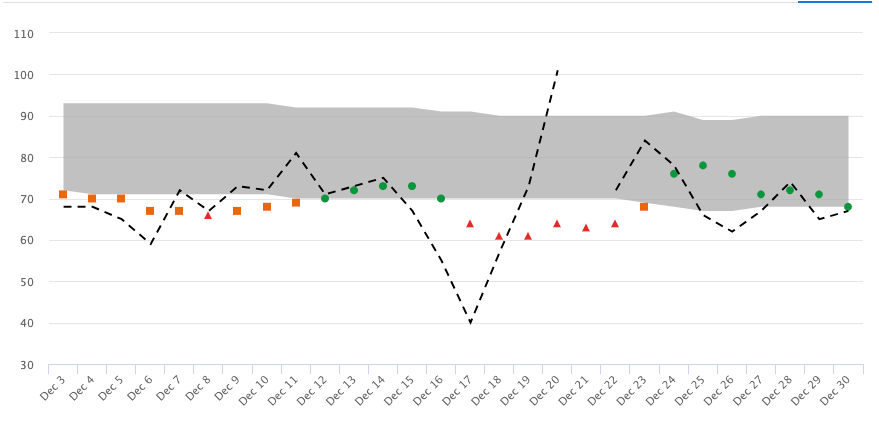Garmin HRV status is one of my favorite metrics on the new Garmin running watches.
I was already a fan of Garmin Body Battery and stress. Now that I upgraded my Forerunner to a Garmin Fenix 7S Pro, I have access to Garmin HRV status as well – and it really steps up the information available about recovery.
If you’re unfamiliar with how it works, check out this post: Garmin HRV Status Explained.
But today, I just wanted to share some examples of what your HRV status will look like when things are not going well.
So What Happened?
I’ve had a busy fall season of racing, and I just raced a 5k on December 9.
After a couple months of training and racing continuously, I was already starting to feel a little worn out. I had planned on tapering a bit in the week leading up to the final race – cutting my mileage back from 70 mpw to 60. Instead, I ended up dropping down to 50.
But the race went well. Afterwards, I was tired, but ok. And then we went out of town for a wedding. In Jamaica. At an all inclusive resort.
That meant late nights, drinking, and lots of partying. I managed to get in an easy run every morning, but as expected my recovery metrics looked like trash.
After we flew home, things were looking up. And then I got sick. Like sick with the flu sick.
Luckily, it was only some kind of one day bug. But throughout that one day, I had a fever, chills, body aches. The whole nine.
Given how my December has gone, I thought it would useful to share the graph of my HRV status over the period to help you understand what your heart rate variability will look like when things go wrong.
My Garmin HRV Status Readings
Here are a few screenshots from Garmin Connect to give you an idea of how the partying and the illness affected my Garmin HRV status.
The First Week – Leaving for Jamaica

The beginning of the week – Sunday – was the day after my 5k. The overnight reading was a little low, but still within the normal range. Things got better the next day with some rest, and things were on the low end of normal throughout the week.
Then, we left for the trip. We flew down to Jamaica on Thursday, so Friday’s reading is from our first night there. The overnight average dropped significantly, and it’s below the baseline. But notice that the 7 day average is still in the baseline, and the overall status is still normal. The nature of the 7 day average is that it’s relatively stable, and it takes more than one night to knock things out of whack.
But things got worse from there. Friday was our first full day at the resort – which meant a couple drinks in the afternoon and a long night of drinking and partying. This is reflected in the overnight average for Saturday – which is now 55ms. That’s well below my baseline, and I think the last time it was that low was the night after my last marathon.
The Second Week – Coming Home and Getting Sick

And here’s the next week.
Saturday night was the actual wedding, and this was the peak of the party for the weekend. We stayed were drinking and dancing, and went out to the sports bar afterwards for some late night grub. The overnight reading on Sunday agrees that this was the worst of it – the overnight average is around 40ms.
Sunday was a bit more relaxed, and Monday we flew home after breakfast. Monday night into Tuesday morning the overnight average is already back to normal-ish – but notice that that actual HRV status is still low. Since this is based on the seven day average, it will take a few days for things to even out.
I got a good night’s sleep Tuesday, and I thought things were looking up. But then I got sick Wednesday. I felt ok at first, and I went for an easy jog on the treadmill. But soon, something felt off. By the afternoon, I had a fever, chills, and an achy body.

Here’s a screenshot of my stress readings throughout the day. You can see things get progressively worse until it’s maxed out by the end of the day. It stayed that way overnight, but I start to recover Thursday morning. And I felt more or less back to normal by Thursday night.
On the HRV status graph above, notice that there’s no reading on Thursday. I guess there’s a point where it gets so low that Garmin just doesn’t register a reading at all. I got a message to that effect Thursday morning on my watch, although I don’t remember the exact wording of it.
I recovered over the next few days, and with the drinking and illness behind my things are getting back to normal.
Is It Bad to Have a Low or Unbalanced HRV Status?
Long term? Yes.
If your HRV status is consistently low or unbalanced, it’s a sign that you’re either a) not sleeping enough, b) working out too hard, or c) adding other stress to your body. Gone unchecked, this could compromise your recovery and ultimately compromise your training.
Short term, though, as long as you know the cause and you accommodate for it there’s nothing to be concerned about.
As you can see from the example above, drinking heavily will lead your heart rate variability to drop – and several days of this will quickly make your HRV status unbalanced or low. Long term, this is not conducive to good training, and most people would advise you to limit your drinking while training. But you’ve also got to live life, and little spurts of partying here and there are fine. Just don’t overdo it with your running at the same time.
You can also see in the example above that an illness will really tank your stress score, your Body Battery, and your HRV status. There’s nothing you can do but wait it out, rest up, and get better. But monitoring the metrics on your watch can help you make sense of what you’re feeling in your body – and confirm whether you’re actually sick or not.
What’s your experience with HRV status been like?
